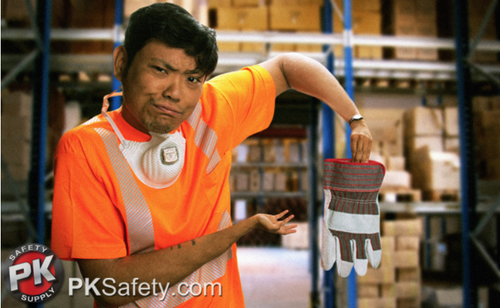Glove Safety - Finding the Right Glove for Your Industry
Gloves used to be easier. There was generally only one size. They either fit, or they didn't. They either worked, or you didn't wear them. These days there are more choices, and it's a good thing because OSHA requires hand protection as part of safety standard 29 CFR 1910.138.
The Bureau of Labor Statistics places injuries to the hands, wrists, and fingers as the second-highest of all workplace injuries behind falls with more than 100,000 annually. The challenge for employers and glove manufacturers isn't just providing more gloves, but providing the right gloves for the job, and one that fits a work force comprised of all sizes of people and hands.
While most hand injuries occur because the worker isn't wearing any hand protection, at least 30% of the reported injuries occur because the glove was not suitable for the work being performed.
There are so many gloves on the market today, with a little research employers can find the proper personal protective equipment (PPE) for the jobs being performed. One of the keys for today's glove manufacturers is dexterity. Years ago when the only type of work gloves were leather gloves for digging ditches, dexterity didn't matter much. But with improved glove design, materials, and manufacturing techniques, gloves have become not only helpful protection but necessary aids to a worker's ability to complete tasks.
Palm-coated gloves such as the popular G-Tek MaxiFlex are designed for work that requires fine motor skills and sensitivity such as automotive repair and product assembly. However, their excellent grip and relative durability have made them favorites in the traditionally more demanding trades such as carpentry and construction.
One size definitely doesn't fit all. Manufacturers understand this, and a good example are the cut resistant MCR Safety 9676 Dyneema Gloves which come in sizes small to extra-large. Even more basic work and construction gloves like the MCR Safety 1400A Leather Palm Work Glove come in four sizes. A properly fit glove provides far superior protection to one where the protective pads and reinforcement are someplace other than where a workers hand fits.
Another improvement in glove safety for workers is due to new materials. Heat resistant glove liners were traditionally made from knits. This style of glove offered great protection, but at a high per-pair cost, and greater bulk to the glove. Thermal protection can now be achieved without costly knits by using stitch-bonding and laminated layers of protection. Because the gloves have protection where you need it, and less material where you don't, they are naturally less bulky, and provide greater dexterity.
Dexterity is the new buzz word for work gloves these days. Manufacturers are providing increased finger and hand mobility through glove design, innovative materials, and construction. And this may be the single greatest benefit of modern gloves to workers, as it allows them to complete their tasks without too much unnecessary exposure of the extra material to get snagged or pinched.
Better movement and fit makes gloves more comfortable. Comfort plays a larger part for worker safety than most give it credit for. Ease in both doffing and donning (to borrow some glove industry speak) and a breathable, well-fitting glove make hand safety more attractive to workers for the simple fact that they feel better when they are on. As anyone involved in work safety will tell you, PPE isn't worth a darn if it isn't worn regularly.
To provide the greatest protection for workers and to comply with OSHA hand protection standards, research safety gloves that work best for the specific tasks performed on your job site. If you have questions about suitability, materials, or fit, please give us a call or contact us online at pksafety.com. We have glove experts here to help.
Thanks for reading.
Recent Posts
-
Promoting Safety: National Work Zone Awareness Week is April 15-19, 2024
Each year, the National Work Zone Awareness Week (NWZAW) places the spotlight on the importance o …Apr 11th 2024 -
Understanding 4 Gas Monitors: How They Work & Why They Are Important
In today’s increasingly dynamic industrial landscape, 4 gas monitors have emerged as critical com …Apr 8th 2024 -
April Showers Require Workers to Wear Hi-Vis Safety Rain Gear
While April showers bring May flowers, they also bring challenges, particularly for those working …Apr 1st 2024





